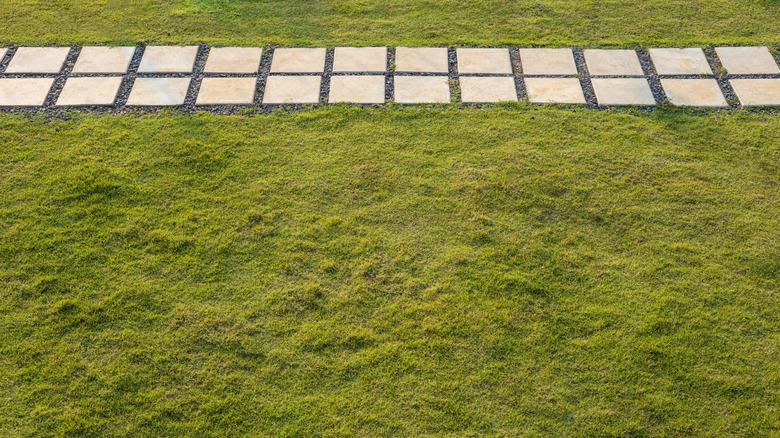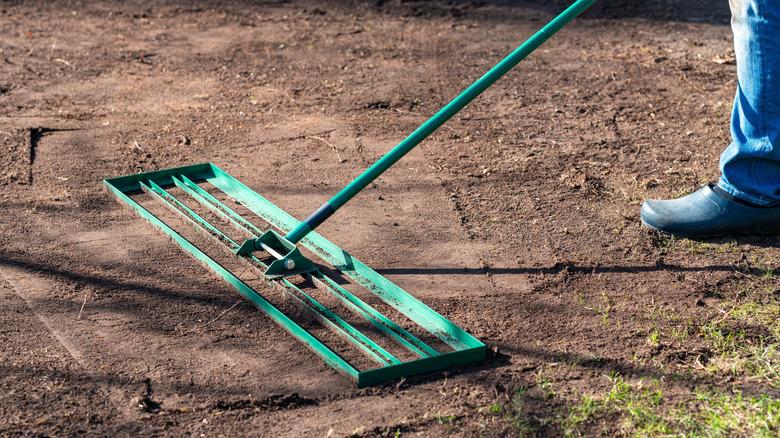The Genius Yard Tool That Makes Leveling An Uneven Lawn A Breeze
We may receive a commission on purchases made from links.
Traditional approaches aren't always the best, however much fondness we have for them. Consider the problem of a lawn with low spots here and there, which leads inevitably to standing water and falling children. The traditional approach to this problem is to name the area, according to how it's afflicted ("the swamp" or "the retention pond" for an area that's often underwater, for example, or "the sinkhole" for a particularly deep hazard). Thereafter, you'd just periodically warn family members and visitors thusly: "Steer clear of the swamp, or you'll sprain your ankle. And there are a million mosquitoes in there, so come in before dusk."
You might have guessed that there's a better way ... maybe even a lot of better ways, depending on the scope of your lawn's problem. If you have a small, barely perceptible unevenness, or a problem you can feel walking around more than you can see, your best bet is probably a lawn-leveling rake, the simplest level of DIY yard grading. This is not how you'd level sloping ground for a swimming pool, when the need for levelness and compaction is absolute. These contraptions look like what you'd get if you built a homemade Swiffer out of angle iron, then forgot to attach the pad. It's essentially a wide metal frame on a longish handle. Its purpose is mostly to push filler material – usually some combination of sand, topsoil, and compost – around so that it fills in the low spots. But a good lawn-leveling rake does quite a bit more than this. If all goes well, you'll end up with a healthier, more level lawn and no more swamp.
What to look for in a lawn-leveling rake
The most common use for a lawn-leveling rake is to push filler or top-dressing material around in turfgrass that you don't intend to disturb. Usually this means adding some sand to a low spot in your lawn. Ideally, a leveling rake will require just one pass to distribute a modest amount of material ... say, a bucketful. That's really just a matter of pushing a pile of sand around. This is easiest with a wide rake (they're typically somewhere between 32 and 48 inches wide) and a long handle (some have telescoping handles you can adjust on the fly), and you might appreciate a padded handle.
You'll also want something built solidly ... probably more solid than you think, because lawn-leveling rakes have another mode that requires more heft, sometimes even being pushed about with bricks stacked on top of the rake head. The weight helps with smoothing operations that disturb the grass and the soil to break up high spots and redistribute the soil to the lawn's low spots. The rake head will probably only weigh 4-8 lbs., so it can be beneficial to add weight so that it bites into the soil better. A few lawn-leveling rakes have tines of a sort, though "teeth" might be a better description. Often, though, particularly with garden and other soil that has already been worked, the design of the rake head is sufficient to disturb and distribute the soil without the additional weight. Gardeners and others might be familiar with this process from using the back of a bow rake, another basic tool for leveling ground.
Alternatives for bigger lawn problems
In fact, you can do this kind of work with a bow rake or its wider cousin, the landscaping rake. Both have tines that bite into the soil (which is why you use the smooth back of the rake for soil that's easily pushed around). But there's nothing easy about smoothing a lawn with any hand-held rake. Fortunately, there's a better way: The drag harrow. Modeled after huge bits of agricultural machinery designed for working plowed fields, the home drag harrow comes in a few forms, all of which are meant to be dragged behind a lawn tractor or ATV. Lawn-sized harrows are perhaps 4x4 feet, and typically weigh less than 200 lbs.
In addition to the designs derived from agriculture – disc, chain, and tine harrows – your lawn tractor can also make use of a drag harrow design that's very similar to lawn-leveling rakes. They are typically an angle iron frame and often include no tines, working somewhat like a big scraper, like a toothless box blade, or road grader. Most models, like this 4 ft. drag harrow from Landzie, are designed to have additional weight stacked on top of them.
You might also be familiar with this concept from a hack that's been around a while: towing a bit of chain link fence behind your riding lawn mower to smooth out a lawn or garden. This works reasonably well, as long as you can add a little extra weight to it. There's an off-the-shelf model available at Home Depot that is basically a chain link drag harrow with a frame designed to accommodate additional weight.


